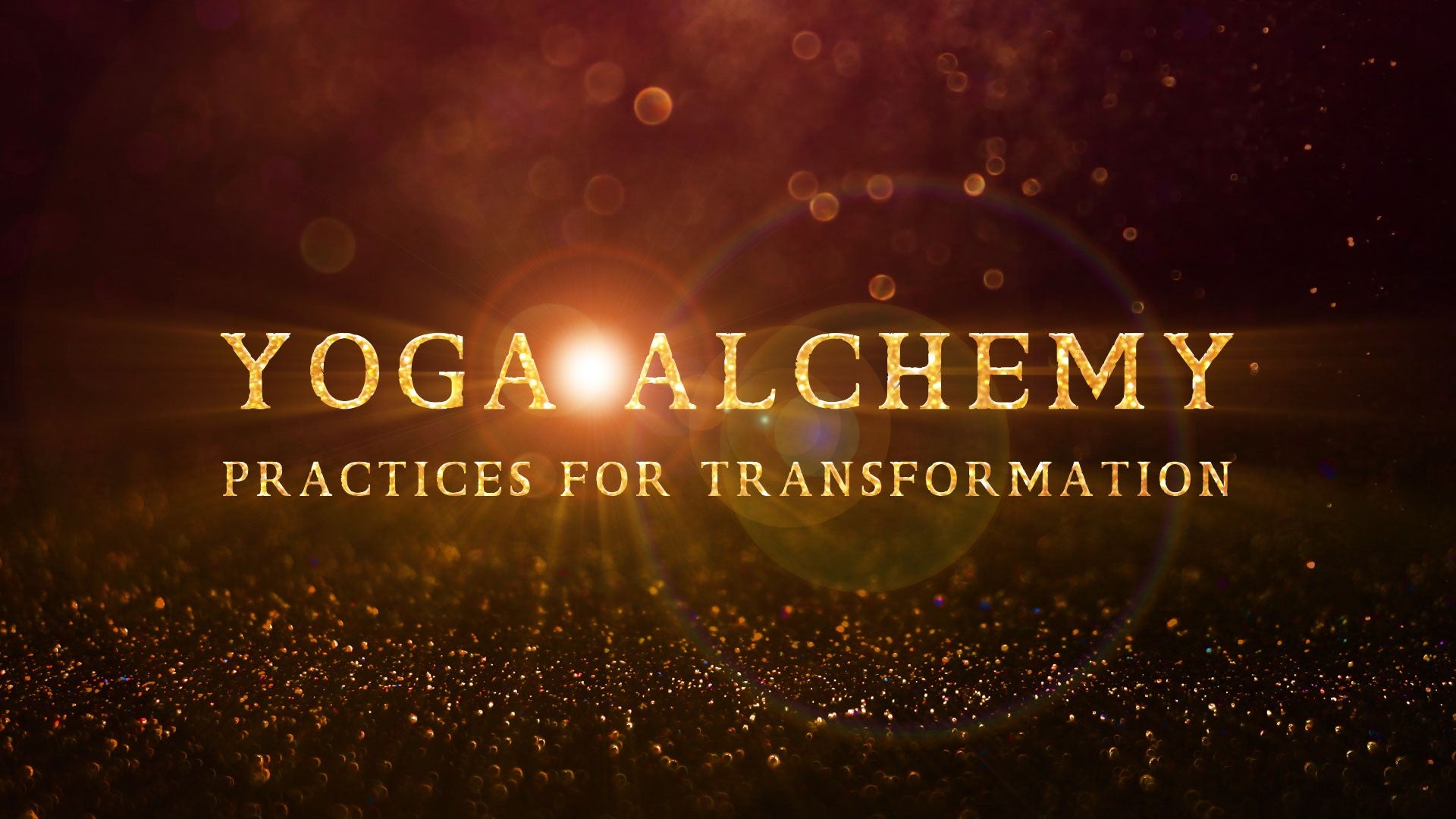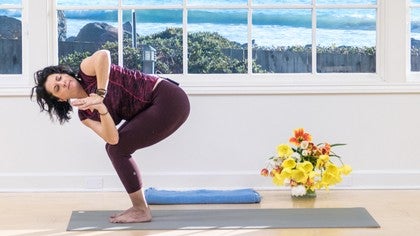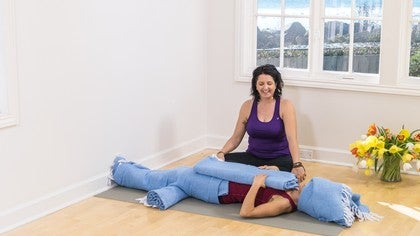Description
About This Video
Transcript
Read Full Transcript
Namaste, welcome to Breathing Heart Flow. This is a sweet sequence that works with the arms and the heart chakra. So as you're practicing this, I want you to be in a state of allowing relaxation to be a part of what's happening. So don't go into work mode in your mind. Go into a mode of, I want to create space around my heart.
I want to engage with the idea of vulnerability and allow that to actually create a strength for you. And one more thing about the vulnerability. As you're moving through this practice and you're learning to express that, it gives you the opportunity to practice doing that in the world. Because what we could do as yogis is we could move into the world with true openness, true fearlessness from a state of allowing the world to touch us, allowing the world to touch our hearts. This is a brave thing, and that's why vulnerability equals strength, because it takes a courage to do something like that.
So let's use this practice to sort of warm up to those ideas and to warm up our heart. I'm going to turn. Go ahead and lay down on your back. And for today's purposes, I want you to keep your legs bent. And I'd like to widen my feet a little bit and relax my knees towards one another.
My arms rest along my side. Feel my breath move. And at first, the only thing that we're really going to be doing is moving our arms. So allow the spine to relax, allow the shoulder blades to relax. Get in touch with the breath.
Bring the chest, swirling around the heart, lots of space. Moving with the breath on your next inhalation, bring the arms up all the way over your head. And as you exhale, bring the arms all the way back down. Let's do that again. As you inhale, arms are floating up.
Just as the inhalation ends, you're fully extended over your head. As you exhale, arms float back. And just as the arms come back to the floor, the exhalation has ended, inhaling and exhaling. Let's do three more on your own because your breathing sequence may be different from mine. You may need to move a little faster with your arms because your breath is a little shorter.
Over time, you'll be able to extend that breath, create a longer and longer breath, both on the inhalation and on the exhalation. This is a sort of refining that you do with the practice of yoga. That's why we love that you're coming to a home practice because this is something that you can take with you no matter where you are. And you can learn to follow your unique rhythms. So the next time you exhale, let the arms just rest on the ground.
Take a moment to notice your eyes. Let them be relaxed. The breath. Notice any sensations in the body. And be free to snuggle into the floor a little bit more.
Make yourself even more comfortable, whatever that means for you. Let's keep the legs bent, but go ahead and let's snuggle a little bit more. This next sequence, we're going to add a lift of the pelvis. So from here, take the feet so they're about hips distance apart. If they've been wider than that, then bring them in.
On the inhalation, the arms are going to float up and the pelvis is actually going to lift at the same time. I'm going to exhale, back down. Pelvis comes down and the arms come down. Inhale, arms are floating up, pelvis is lifting. At the top of the inhalation, my pelvis is as high as it's going to go and my arms are finished releasing.
As I exhale, the movement of the pelvis down towards the floor is slow, it's following the cadence of the arms. Three more on your own. Remember that your breathing sequence may be a little different from mine, so you may be moving a little bit faster than me and that's fine. That's okay, you just let that happen. Now when you're at the top of the inhalation, feel a brief pause.
And when you're at the end, at the bottom of the exhalation, also feel a brief pause, like let there be a moment where you just sort of relax at the end of that exhalation. And let there be a moment where you feel like everything's coming together at the top of the inhalation. Now the next time you exhale and your arms come back down to the floor and your pelvis comes down, just rest there, go ahead and turn the palms up for a moment. Keep the legs bent, keep the feet pressing on the ground. Now we're going to take a similar posture, but we're going to hold it this time.
So my arms are going to go up as I inhale, my pelvis is going to go up, but I'm going to hold this, and in my mind I'm going to count. And you get to count for yourself either up to three, or up to five, or up to seven. Just breathe there, holding a more static posture. When you do come down, the arms follow the pelvis just as before, and you're going to rest here. So at this point let's roll to the side, and bring yourself up to sitting.
I want to introduce the strap to you. Now you don't need a strap in order for this practice to be totally yummy, but with a strap you get a little bit extra support to the heart. And I am using a yoga strap, so I'm going to unwind it here, and I'm going to take that strap to the back of the ribs just underneath the breast. Now the trick to using this strap in this way is not to make it too tight, but the other trick is to not make it too loose, so it's kind of fun. What this is going to do is this is going to give us an awareness as we move through these movements of where our breath is going.
So you're going to snug it in, you see how I have that kind of snug, I can still get my fingers under there. But when I take an inhalation, I can feel a little hug from the strap. Now I'm not taking a super big inhalation, I'm not asking for a gigantic inhalation, so if you don't really feel it, snug it in a little bit more. When you take that normal inhalation that you've been doing, you're going to feel the entire circumference of the strap. This is so super cool.
Now you're familiar with the work just with the arms, and you're familiar with the work with the arms and the lift of the pelvis. We're going to go back and redo those so that you can feel those with this type of support. And we're going to focus our attention to creating space in this area, which is going to allow space for the heart. So lay back down, here we go. Same same, legs are bent, arms are to the side.
We'll take five of these breaths, and remember you're following your own unique rhythm of your breath. So maybe if you're practicing with a friend, they're going to get three breaths, but you're going to do five breaths, or they're going to do five breaths and you're going to do seven breaths. I'm going to count out mine and let you know when we're going to move to the next thing. Whenever you're ready, just the arms, inhaling, focus your attention on the strap, and exhaling. Keep going.
Breathing into the area where the strap is. If you can't feel it, which sometimes happens because of the change of the position of the body, just snug the strap in a little bit more. Feel that breath opening the side body, opening the back body, opening the front body. Remember that. The arms are going overhead when you inhale, and they're coming back down beside your hips as you exhale.
On your next exhalation, just rest the arms for a moment. Make a determination if you need to snug the strap in a little bit more, or maybe loosen it a little bit. Remember, we're being kind here. We're creating this feeling of space in the heart by giving us a sensation to breathe into. Giving us something to breathe into.
Let's do the second sequence now. I'm going to inhale. Arms are going to go up and the pelvis is going to go up. Back down on the exhale. The pelvis and the arms are moving in harmony.
Four more on your own. Follow your breathing sequence, your breathing rhythm. Breathing into the strap. On your other right. The next time you come to an exhalation, let the arms rest on the ground.
Breathe into the strap, filling up the heart. Now reposition the feet if you need to so they feel nice and stable. We're going to go up where we hold the bridge pose. Check your strap, make sure you still like the firmness of the strap. On an inhalation up you come, see if you can hold for 3 breaths, maybe 5, maybe 7.
How you'll know how long you hold it is how stable you feel. Don't get trembling, no quaking. Each breath you're breathing into the strap. We're doing this to create freedom, create freedom. You bring your pelvis down, the arms come back down as well.
Take a resting pose, take your left hand to your left knee, your right hand to your right knee, but keep the arms straight. Relax the legs, so the only real thing working are your hands hanging onto your knees. Relax the belly and the eyes and breathe into the strap. Just count 5 breaths here. Release the feet to the floor now.
Arms to the side, let's do both of those one more time, so inhale reaching over, lifting, breathe into the strap, 3 breaths, or maybe 5, maybe 7. When you do come down with your exhalation, the pelvis and the arms move in harmony together. One hand to one knee, one hand to the other, arms are straight. Hold onto the knees, but relax the pelvis, so the weight of the legs actually helps to straighten the arms. 5 breaths, let the knees come down now.
You're going to keep the strap on, let's roll to our side, all the way up, being really nice with yourself as you sit up. So we're going to come to standing, but before you do, gather your tail, if you have a nice long strap like I do, it's going to get in the way. You're going to probably step on it, so I want you to take it and fold it up a little bit and stuff it into the back of your pants, can I say that on film, I'm going to say it. Stuff it back there, so that when you come around and you come to standing, it's not in the way, you're not going to step on it. Come to the front of the mat now, decide, is it firm enough, do you feel firm enough with the strap around yourself, and if it feels good, let's take a breath just in Tadasana, the inner thighs release back, collarbones wide, just breathe normally.
So in breathing normally, if you aren't feeling the full circumference of the strap, maybe tighten it a little bit more. If you're feeling it almost immediately when you start the breath, it's probably a little too tight. So get the perfect place with the breath, you don't want it to limit your breath, but you want to be able to feel it, right? So here we go, standing, feet together, slightly separated, that's up to you, we're going to take a nice inhalation, bring the arms up, get nice and tall, and breathe into that strap. Do a little tiny back bend, might feel the strap a little bit less there, folding forward now, let's come to Uttanasana, probably feel the strap a little bit more here, breathe into the strap, feel the full circumference.
Bend your legs, take the hands to the floor, keep your mind concentrating on, breathing into the ribs, breathing into that strap, hello train, so I'll start at this point. So you're probably going to feel the strap nice and snug around you, just breathe into that area, we're creating space for the heart, so fill up the chest with the breath. And lower to your knees, sit back on the feet, we're going to take our arms behind us and lift the chest and breathe into that same space of the chest, come back to sitting, if that's tough on your legs, you can always do this instead of coming all the way down to the floor, so just make that decision, but from here, rolling all the way forward, coming to downward facing dog, breathing into the strap, walk your hands back to the feet, inner thighs sliding back, sacrum deep, your mind is attentive to the strap and the breath. Bend the knees, roll yourself up, arms all the way overhead, hands coming down, Anjali Mudra right at the heart, let your thumbs touch the chest just lightly, and take a little meditative walk to the front of your mat. Feel the breath, feel the support of the strap, things may have changed a little bit, do you need to snug the strap in a little bit more?
If you do, go ahead and do that now, arms up, here we go again. Little back bend, exhaling and folding, Uttanasana, clasp the elbows, draw the spine long, breathe into the strap, release the hands, bend the knees if you need to, let's step into downward facing dog, down to your knees, either come to kneeling if you need to, or come to sitting on the feet for a modified Ustrasana camel pose. Breathe into the strap. Going forward again into downward dog, feet are firm, walking the hands back, Uttanasana, bend the knees, arms up, palms together, Anjali Mudra. Meditative walk to the front of your mat, so don't hurry here, it's sweet, keep it sweet.
Do one more, inhale, arms up, little back bend, exhale, Uttanasana, bend the knees, hands come to the floor, downward facing dog, the mind is centered on the sensation of the strap it's creating, down to your knees, choosing your Ustrasana, Adho Mukhasvanasana, Adho Mukhasvanasana, again the hands to feet, Uttanasana, all the way up to standing, hands to Anjali Mudra, quiet meditative walk to the front of your mat, and just bring yourself down to the mat, sit back on the feet, let your eyes close for a moment, feel the quality of the body, the quality of the mind, so now we're going to move to the floor but I'd like you to keep your strap on, you can take the tail out like this because we're not going to be walking around anymore, you'll need a couple of blankets and if you have it grab an extra strap, so here are my blankets. The first blanket is going to be used to kind of catch the arms, so I open it to this shape and I'm going to fold it into a third, sort of looks like that, those are for the arms. The strap, the extra strap if you have one you're going to put a loop in that extra strap, this is going to be for our calves, I'll show you that in a minute but go ahead and put a loop in that strap, lay that out to the side right there, and then the final blanket we're going to roll a very narrow tube, so four fold, there's four layers here, I'm rolling from the really long end just like this, so it looks like that, this is where the strap is going to go, so the strap that I have on my body is going to go right in the center channel of this little blanket, my body is here on my shoulders, my head and my arms, so my head's not going to be on that blanket, it's really quite yummy, it takes a minute to get into. If you have an extra strap, you're going to strap your calves, the thickest part of your calves, but there's space in between my legs, that's super important, don't haul them all together, you want some space in there, it'll feel nicer and it's better for your pelvis. Now I figure out where my strap is, I lower myself down so that that part of my back is resting right on that roll, now if your roll is too thick it's not going to be comfortable, so some of you may need to already sit up and make your roll thinner and that's fine, go ahead and do that, I'm going to resist the strap at the calves, just enough so that as I straighten my legs out my spine gets a nice release, and then I'm going to take my arms over my head and rest my arms, actually my wrist on the blanket, so my head you see is not on the blanket, my arms are extended, they're actually not fully extended, I'm extending them here and then I'm relaxing them, so there's going to be a little bend in the arms, I'm resisting the strap at the calves, and then I'm relaxing the legs, it's going to keep them a little more in a neutral position, they might wiggle around a little bit, don't worry about that, and in this position I'm just going to concentrate on the open quality of the chest, with each inhalation, and the softness of the chest with each exhalation.
Be sure to let your eyes close, if you're noticing that your eyes don't want to close, it's probably because the roll under your back is too thick, or the support under your arms is too low, so you can make those adjustments if you want to roll to your side, make those adjustments so that the arms are more supported, and the roll under the chest is less thick. I'm going to be here for a few breaths, this is a wonderful way to unwind the chest and the flow has been giving us everything we need to be able to be here in a more peaceful manner. The bones surrender, the arms and legs relax, you may even notice that your arms even bend and relax even more, and that's fine, just let them surrender, your body's going to go where it really needs to go. Let the jaw be soft, let the eyes feel as though they drop back into the sockets. And deepen your breath, I want you to slide the legs towards each other, if you left enough space between your legs that means that that strap that you had around your calves, it's easy to kind of wiggle that off.
Bring your hands to your torso and let your legs bend. Shift your hips over to the left, you can roll onto your right side, and use your arms to press yourself up. You'll remove this blanket, place it off to the side, remember what I said about keeping your props neat, so when you place it to the side place it with some consciousness, do the same with the other blanket, we won't really need them for this. Your extra strap can also go to the side, and then the strap around your chest you're going to loosen that, and you're actually going to take that completely off, but we're about to use that strap, so once you loosen it, make it a little bit wider, and I'll show you what we're going to do with it. Take it completely off, you want it to be about as wide as an oversized beach ball, not like this, and then just take it under your legs, back around to the low back right here, bend your legs and put it around your knees like this, this is going to let you know how wide it needs to be.
Take it up a little higher, it's going to be a little less obvious how wide it needs to be, to your right here. Now take it off, but not all the way off, just slip it off your legs, roll onto your back, this is like one of the most magnificent things on the planet, so I'm really excited you're about to learn it, I love this. Draw your legs into your chest, strap over the legs, snug in the strap until you can relax your legs in an inverted child's pose, just like this. Now if this is too much for your knees, then what you do is you make the strap big enough to take behind your legs, just like this. Now it's not going to compress the knees, but it's still going to hold you in the appropriate shape.
The most important part of this is that the strap is in the same spot it was earlier, it's way up on the ribs, same exact spot. If it's down lower than that beyond the ribs, then it's in the softer tissues where the kidneys are and it's not comfortable there, it won't be good for the body. So make sure it's up in the rib area, make sure it's firm enough that it's holding the legs, you don't have to do anything, but just relax your legs. This is really one of the most amazing restorative postures there are and it's so simple. It's great for low back pain and any type of low back distress that you get relief from in a forward fold.
So let your eyes close, let the strap hold you. It doesn't have to be tight, it just has to be at the perfect level that the legs can relax and not fall away from the body. Even though the strap isn't on your body anymore, you can probably still feel the impression of the strap, so be conscious of that and be conscious of the space that's been made around the heart, the movement of the breath. The jaw is soft, the eyes are soft, the breath slows. So the more still you become, the more quiet, the less oxygen your body needs and the slower you'll breathe.
So even though we learn some breathing methods for relaxation that include bringing a lot of air into the body, when you're really dropping deeply into a restoring aspect of your nervous system and your body, your breath becomes shallow. All right. This is another posture that you can be in for some time. You could be in this for five or ten minutes. But we're going to move into Shavasana now.
So to come out of this position, if the strap is over your shins, you can just pull the strap and then take the feet to the floor. If it's under the hamstrings for the sake of the knees, you'll have to loosen the strap and slide it down to the floor. Either way, the feet come to the floor. Shift your hips again to the left and roll to your right side. Keep rolling, let the arms bring you up, and let's prepare for Shavasana.
Now one of the things that I love about working with the yoga props is there's a lot of folding and unfolding, but a lot of times you don't even have to do that so much. So the long tube that we've created that we used earlier, we're going to take that and just let that be the blanket for our legs. I'm going to put that right here. I'm not even going to worry about re-rolling it. It's fine just the way that it is.
And then the blanket for the head, we'll just unwind that blanket. So when you're moving into Shavasana, try not to be too active. We're cooling and we're winding down. We don't want to wind up to get into Shavasana. Does that make sense?
So I'm lowering myself down, the legs extend supported by the blanket, something soft under my head, and I allow my eyes to close. The body's just done a tremendous amount of unwinding, so Shavasana and its effects are very close, relaxed fully. So much space was created for your beautiful heart. Let the heart bask in that space. Let your breath be organic and the bones heavy.
And the volume in the mind turned all the way down. That's it. Allow yourself to continue to rest. I'm going to come to sitting to sing you a song, but you can remain in your Shavasana. So, this practice is a practice of setting the breath free.
And over the period of the sequence, deep unknown obstacles were melted. So I'd like to honor that with a song to Ganesha. Shrim Shrim Klim Ganesha Shrim Shrim Klim Ganesha Ganesha Ganesha Shrim Shrim Klim Ganesha Om Glam Glam Gom Glam Glam Gom Glam Gom Gom Gompak friends Gom Glam Gom Gom Gom Gom Gom Gom Gom Gom Gom, Gom Gom Gom Gom Shri Mkhleem, Ganesha, Shri Mkhleem, Ganesha, Ganesha, Ganesha, Ganesha, Ganesha. Now let your breath deepen. Let your body move in whatever way feels natural to you.
Can bend the legs. And with care, shifting your hips to the left, roll onto your side. Bring yourself up using your arms, letting your head be the last thing that rises. Coming to sitting. Bringing your hands together at your heart.
Bowing your head to acknowledge yourself for bringing yourself to your yoga mat, having a willingness to create space in your heart for vulnerability. I thank you. Peace out. Namaste.
Yoga Alchemy
Comments
Much Love!
You need to be a subscriber to post a comment.
Please Log In or Create an Account to start your free trial.

















